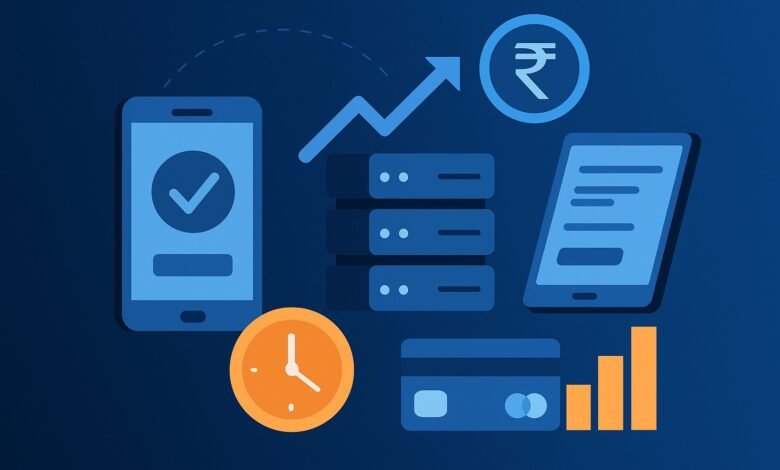How the UPI Wake Up System Enhances Real-Time Payment Reliability

Introduction: A New Era of Payment Reliability With the UPI Wake Up System
The digital payments landscape has evolved at a pace that few industries can match. As billions of transactions move across mobile apps, banking servers, merchant gateways, and API-driven platforms, the need for reliability has never been more urgent. Delayed payments, failed attempts, session drops, or slow bank responses can cause significant friction for users and businesses alike. To address these challenges, a powerful technological framework has emerged in the Indian payments ecosystem: the UPI Wake Up System.
The upi唤醒系统is a specialized mechanism that maintains continuous connectivity between banks, UPI apps, and merchant platforms, ensuring that every payment request is processed in real time with maximum stability. Unlike conventional systems that wake up only when a transaction is triggered, the UPI Wake Up System keeps payment channels pre-activated, monitored, and optimized.
In simple terms, the UPI Wake Up System ensures that digital payments never “sleep,” preventing delays, failures, and downtime. This article explores how the UPI Wake Up System enhances real-time payment reliability for businesses, fintech platforms, merchants, and end-users across India and beyond.
What Is the UPI Wake Up System?
The UPI Wake Up System is an infrastructure enhancement designed to keep UPI payment pathways in an always-ready state. Instead of allowing bank APIs, nodes, or settlement channels to enter idle mode, the UPI Wake Up System continuously “wakes up” or triggers the pathway at predefined intervals. This maintains persistence and stability in communication.
Core functions of the UPI Wake Up System include:
- Maintaining active sessions with UPI servers
- Preventing bank downtime from disrupting merchant transactions
- Keeping API communication channels pre-validated
- Ensuring faster payment request handshakes
- Reducing “Pending” or “Timed Out” status
- Improving overall transaction success rates
The entire structure is engineered to improve reliability on both the front-end and back-end, creating a smoother payment experience across platforms.
Why Traditional UPI Systems Face Reliability Challenges
Before understanding how the UPI Wake Up System enhances reliability, it’s important to analyze why traditional systems sometimes fail.
Idle Server Timeout
Most banking servers have timeout rules. When inactive for some time, they become slower to respond when the next request arrives. The UPI Wake Up System solves this by sending periodic background signals.
Sudden Traffic Surges
During:
- Festival sales
- Salary days
- High-volume periods
- Mega e-commerce events
bank APIs may get overloaded. The UPI Wake Up System reduces load spikes by prepping channels beforehand.
Dormant UPI Modules
Some banks’ UPI modules enter sleep mode during low activity hours. This causes slower response times at peak times unless reactivated.
Session Drops
When communication between the merchant and bank breaks abruptly, transactions fail. The UPI Wake Up System maintains session persistence.
Poor Routing
Without intelligent routing, payment requests flow through high-traffic bank nodes and fail more frequently.
The UPI Wake Up System directly solves each of these issues.
How the UPI Wake Up System Enhances Real-Time Payment Reliability
Below are the real, measurable ways the UPI Wake Up System boosts reliability.
Always-Active UPI Channels for Faster Response Time
One of the most important contributions of the UPI Wake Up System is ensuring that payment channels remain awake 24/7. By periodically triggering pre-communication signals, bank nodes are kept active and ready.
Benefits:
- Faster initial handshake
- Reduced transaction delay
- Improved success rate
- Lower server latency
Instead of waking up during the transaction, the UPI Wake Up System ensures the route is ready ahead of time.
Higher Transaction Success Rate
A high failure rate can damage the credibility of businesses. When users frequently face:
- “UPI Payment Pending”
- “Transaction Timeout”
- “Bank Server Not Responding”
they lose trust in the platform.
The UPI Wake Up System reduces these errors dramatically by:
- Warming up servers
- Maintaining persistent communication
- Reducing network fluctuations
- Preparing bank APIs before the user makes a payment
Merchants see a significant jump in success rates when using a UPI Wake Up System.
Eliminating Bank Downtime-Related Failures
Bank downtimes are one of the biggest disruptors in UPI payments. The UPI Wake Up System monitors bank performance continuously. When it detects an unstable banking partner, it automatically reroutes payment requests to alternate nodes.
Effects:
- Payments process even if a bank experiences downtime
- Failures due to inactivity are eliminated
- Smart-switching keeps the user experience uninterrupted
This contributes massively to real-time reliability.
Real-Time Monitoring and Automated Error Recovery
The UPI Wake Up System constantly analyzes:
- Server health
- Payment speed
- API error frequency
- Routing performance
If it detects anomalies, it:
- Adjusts routing
- Triggers new wake-up cycles
- Reconnects broken sessions
- Updates merchant systems instantly
This level of automation ensures reliability without human intervention.
Ensures Peak-Time Stability
During high-traffic events, the UPI Wake Up System:
- Preloads system pathways
- Maintains consistent UPI API activity
- Reduces bottlenecks
- Stabilizes banking endpoints
This is why top e-commerce platforms use wake-up systems before launching major sales.
Prevents Idle Session Failure
Idle sessions are problematic because they lead to:
- Slow authentication
- Delayed response
- Timeouts
The UPI Wake Up System prevents these by keeping channels refreshed and eliminating session idle periods.
Better Fraud Monitoring and Security
Since the UPI Wake Up System keeps channels active and monitored:
- Suspicious patterns are detected early
- Fraud attempts are flagged in real time
- Transaction anomalies become more visible
This results in:
- Safer payments
- Less fraud
- Cleaner transaction logs
Security becomes stronger simply because the system stays alert.
Technical Architecture Behind the UPI Wake Up System
While the exact architecture varies by payment provider, the core components remain similar.
Persistent API Communication Layer
This layer keeps UPI nodes active through heartbeat signals.
Smart Routing Engine
Intelligently redirects traffic to the fastest and most reliable banking node.
Multi-Node Banking Connectivity
If a bank ecosystem becomes unstable, the UPI Wake Up System switches instantly.
Real-Time Monitoring Dashboard
Tracks performance metrics including:
- Bank uptime
- Error types
- Latency
- Transaction volume
Automatic Failover Mechanisms
Ensures payments do not stop even if:
- A server crashes
- A banking endpoint goes offline
- Network issues arise
Transaction Validation and Logging
Every transaction is logged in real time for:
- Fraud checks
- Error handling
- Audits
- System optimization
Use Cases: Where the UPI Wake Up System Matters Most
E-Commerce & Marketplaces
High volumes require stable UPI performance.
Gaming and Instant Deposit Platforms
Users expect immediate confirmation.
Fintech and Lending Applications
Loan disbursement and repayments depend on stability.
Subscription Services
UPI mandates become smoother with always-awake channels.
High-Frequency Transactions
These businesses handle thousands of payments per minute:
- Taxi apps
- Food delivery apps
- Utility services
The UPI Wake Up System ensures consistency.
How Businesses Benefit from the UPI Wake Up System
Reduced Customer Complaints
Fewer timeouts → happier customers.
Higher Revenue
More successful payments mean fewer abandoned carts.
Operational Efficiency
Automated routing and monitoring reduce manual intervention.
Better User Trust
Reliability boosts brand reputation.
Improved Financial Accuracy
Real-time callbacks improve reconciliation accuracy.
Future of the UPI Wake Up System
With India’s payment ecosystem growing rapidly, the UPI Wake Up System will integrate with:
AI-Driven Routing
Machine learning will choose the best payment path.
Cross-Border UPI Transactions
UPI is expanding globally.
Blockchain-Based Logging
Immutable transaction logs will improve audits.
Predictive Error Prevention
Systems will identify failures before they occur.
Offline UPI Support
Wake-up systems will help offline payments sync instantly when the device reconnects.
Conclusion
The upi唤醒系统 is a revolutionary advancement designed to keep digital payment pathways active, reliable, and fast. It enhances real-time payment reliability by:
- Keeping UPI channels awake 24/7
- Reducing downtime
- Improving transaction success rates
- Eliminating idle session issues
- Monitoring system performance
- Maintaining stable routing
As India—and the world—continues to evolve toward instant, secure, and API-driven payments, the UPI Wake Up System will be a core technology enabling the future of reliable digital transactions. Businesses adopting this system gain a competitive edge with faster payments, happier customers, and stronger reliability.





